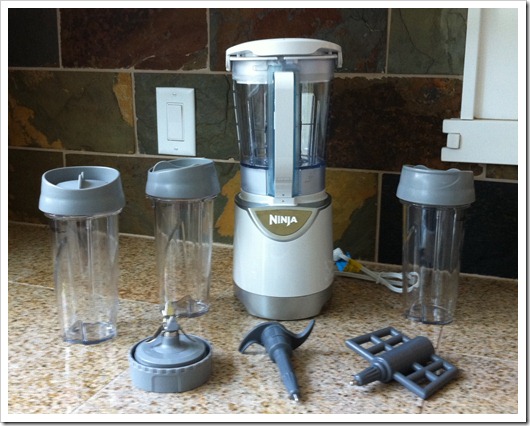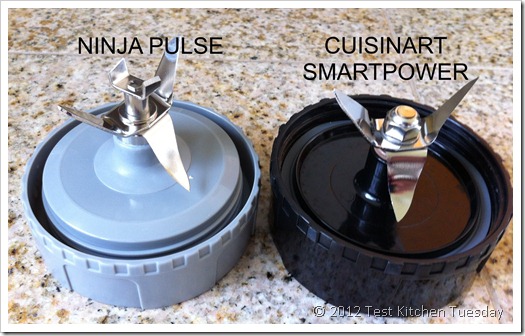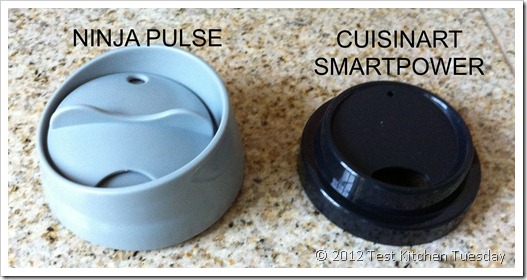Product Review: Ninja Pulse Blending System
“How did you become this blender person?” 2Chili asked inquisitively when I showed up with yet anotherblending device around the holidays.
Truth be told, I don’t really know how it happened, it just did. Last year, when I broke our traditional blender, I replaced it with a Ninja Professional Blender, wrote a little review, and BAM, it seemed like I had created a repository of blender recipes almost overnight. And, I started getting a ton of people stopping by the blog to ask questions about their Ninja Blenders.
Fast forward to today, and, I felt compelled to pick up a Ninja Pulse to try it out. The Ninja Professional Blender is great, but, it is pretty big. I don’t always want to blend 72 ounces of things, and, I don’t always want to clean a 72 ounce jar!
The Pulse appealed to me with its individual cup blending, as well as a blender jar option for larger jobs. I already have a similar blender to the Pulse, however, the Pulse does have some significant differences over the Cuisinart SmartPower that I have, which I’ll get into later in the review. As an aside, I looked into the Magic Bullet for quite some time before deciding not to buy it based on many people’s reviews that they burn up quickly.
That said, let’s get into the review, shall we?
What it is: A multi-container blending system. The Pulse is a likely competitor to the Magic Bullet, yet it doesn’t have quite the variety of blending cups for which the Bullet is known.
Out of the box, you get:
- Blending jar, with a blending blade, a dough blade, cookie paddle and storage cover, should you wish to store something in the blender jar. In traditional Ninja fashion, the blending blade goes through the middle of the jar and has four blades, instead of traditional bottom-of-the-blender blades.
- Three to-go cups with lids
- A to-go cup blending base, which is somewhat traditional, with a slight twist, which I’ll get to shortly
- A recipe manual, user’s guide, and warranty card (not pictured)
I will admit to being slightly confused when I pulled the Pulse’s blending jar out of the box, as the lid doesn’t lock down. Loyal Ninja Professional Blender users know that the lid must lock down to blend.
Ah, but this is where the Pulse is different. There are no blending speed options with the Pulse – it…well…it pulses. Don’t get me wrong, you can perform steady state blending, but the unit is a little different from most blenders.
- With the blending jar attachment, you lock the jar into the base by twisting it to the left, and then, you use the “loose” part of the lid to activate the blender. Tap it lightly, and the unit will just pulse. Hold it down, and the unit will blend steadily
- For the individual cups, you drop the cup with the blending base attached into the base of the blender, and by pressing on the top (really, the bottom) of the cup, the Pulse becomes engaged. Press and release for pulsing, press and hold for blending.
Getting the right “touch” for pulsing can be a little bit of a learning curve, but once you’ve blended a few things, you’ll have it down pat.
General Observations
Aside from there not being any buttons to press to blend, the other striking difference from the Ninja Professional Blender is the size of the Ninja Pulse. It is much more “normal” in size, and fits easily under my upper cabinets, whereas it’s a very tight squeeze with the Ninja Professional Blender.
I make a lot of smoothies, which is why I originally bought the Cuisinart SmartPower system, and which makes the Ninja Pulse highly appealing. Multiple cups and a blender jar means I can blend on an “as-needed” basis a couple times a day without having to wash the container each time.
When I bought the Cuisinart, the Ninja Pulse wasn’t on the market yet, which is too bad – because it is quite a lot better than the Cuisinart.
| Ninja Professional Barely clears the cabinet (the white at the top of the photo). 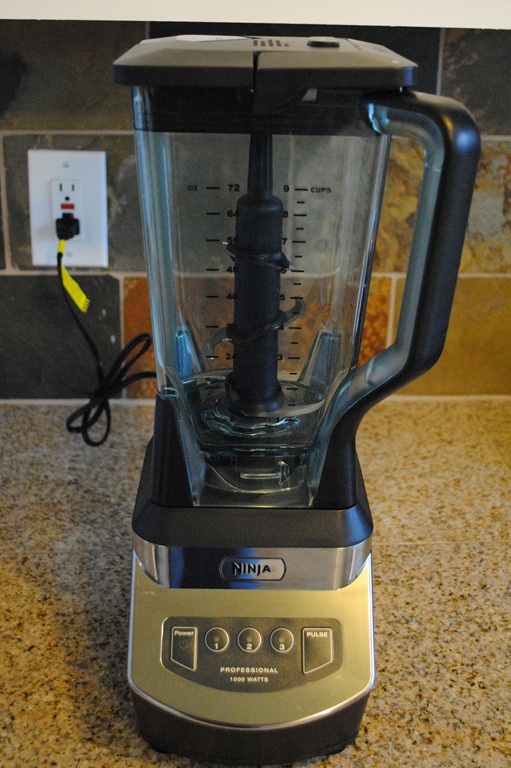 | Ninja Pulse Easily clears the top of the cabinet, with about six inches to spare. 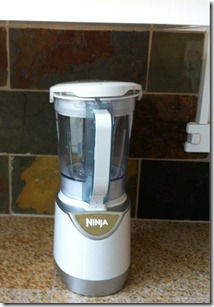 |
When considering the Ninja Pulse, I couldn’t quite figure out how the blender jar really works – and the photos from Ninja didn’t really help! 
There is a bit of an optical illusion that happens because the jar locks into place with the handle facing to the front, it looks as if the jar is divided, but it isn’t.
In reality, the suggestion presented in this photo from Ninja is not physically possible. You wouldn’t mix cookie dough and salsa at the same time (or if you did, you’d get salsa cookies).
Comparing the Ninja Pulse to the Ninja Professional Blender
When deciding which of these blenders is right for you, I really think it depends on the type of blending you do, so here is a little comparison of the two.
Volume. The Ninja Professional Blender has a ton of volume in the jar (72 ounces), which is great if you perhaps make a lot of blended soups or smoothies for more than one person. On the other hand, the Ninja Pulse is great for smaller jobs and individual sized smoothies. Blending in the to-go cups is so convenient, and, the tops for these cups are great because you can open and close the lids, making them good to take in the car.
Power. The Ninja Professional Blender has 1000 watts of power – quite a lot for a blender. I haven’t found anything it won’t blend yet, including rock hard frozen winter squash. The Ninja Pulse has 700 watts of power – quite ample for the size of the blender jar and blending cups. In fact, it far exceeds the Cuisinart SmartPower system I have. There are no variable speeds for the Ninja Pulse, but the one available speed seems to be more than sufficient.
Ease of Cleaning. This is one area where they are pretty much exactly the same. It is so easy to clean both of these blenders. They both have removable blades for the blender jar, and all the pieces are dishwasher safe. Ninja has figured out “cleanability.”
Number of Blades. The Ninja Professional Blender has six blades that run through the middle of the blender jar, which shred just about anything. The Ninja Pulse has four blades, also running through the middle of the blender jar, and also which shred just about anything. The individual cups rely on a more traditional blender blade design, with some enhancements.
Comparing the Ninja Pulse and Ninja Professional Blender with the Cuisinart Smart Power
Retail Price | Power (Watts) | Multiple Blending Speeds? | Easy-to-Clean? | Blends without “burning” or jamming? | Accessories Included? | Replacement Parts Available? | |
| Ninja Professional Blender | $99 | 1000 | YES | YES | YES | NO Unless you buy the more expensive Ninja Kitchen System) | YES But fairly expensive compared to cost of unit. |
| Ninja Pulse | MSRP $109 Have found as cheap as $79 | 700 | NO | YES | YES | YES 3 To-Go Cups/Lids Dough Paddle Cookie Dough Paddle Blender Jar/Blades | YES But fairly expensive compared to cost of unit. |
| Cuisinart Smart Power | MSRP $130 Have found as cheap as $53 | 350 | YES | YES | NO This blender can really get bogged down, especially when blending in the to-go cups | YES Blender Jar (uses same blades as To-Go Cups) Nut Chopping Blade and Cup | YES But fairly expensive compared to cost of unit. |
Single Serve Blending
One thing that makes the Ninja Pulse single serve in-cup blending so good — in addition to its sheer power — is the unique take on the blending blades. At first glance, they are just normal blender blades. But, compare them side-by-side to the blades from the Cuisinart SmartPower, and you can see a slight difference with the addition of an extra set of blades in the center. I really believe these extra blades prevent that gumming up that can happen with traditional blender blades, because they keep everything moving.
Another great feature is the locking lid for the to-go cups. The Cuisinart cups have lids that are always open, but, the Pulse has lids that can be closed, making them ideal for taking your morning smoothie to go.
Note: A reader correctly informed me that the Ninja Pulse lids do not completely seal when closed. There is a small gap, where if the cup tips over, liquid could spill out. Worth noting!
Ninja Pulse Pros
- Variety of blending options, from the blender jar for large jobs to the single serve cups for small jobs
- Ninja’s unique multi-blade blending in the jar results in fast, consistent blending every time
- Smaller in form factor than its big brother, the Ninja Professional Blender, but able to produce similar results
- Blender jar has a pour spout for easy pouring of contents without removing the blades
- Super easy to clean
Ninja Pulse Cons
- No variable speeds – you can either pulse or blend at one steady state rate
- Takes a bit of time to get used to the “touch” required to make the unit pulse or blend
- A tad on the expensive side, unless you find it on sale
The Verdict – Which One Should You Buy?
There has been a lot of discussion in the comments section on several pages on this blog with folks trying to decide which blender to buy – the Ninja Pulse or some variant of the Ninja Professional Blender.
While I can’t tell you which one is best for you, I’ll tell you that I have put the Ninja Pulse through the paces over the past coupe of weeks, and haven’t found a scenario where it doesn’t perform to my satisfaction. In fact, I have been really very pleased with it! It blends everything I throw at it with ease – frozen fruit, big batches of butternut squash soup, smoothies galore, even dog biscuits (we chop up large dog biscuits into smaller ones so our dog doesn’t get too much at once). I have determined that the Ninja Pulse can do pretty much anything its big brother can do.
The only area where I think you might not be satisfied with the Ninja Pulse is if you regularly need multiple blending speeds, like making nut butters, where variable speeds are valuable. So, it really comes down to your individual needs and if you prefer the single serve blending option available with the Ninja Pulse.
############################################################################
If you enjoyed this review and decide to purchase this blender, purchasing from Amazon via this link – Ninja Pulse – helps support Test Kitchen Tuesday by providing a small referral fee from Amazon. Thanks for stopping by!

